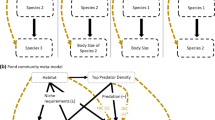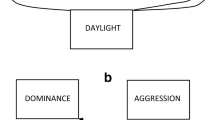Summary
We used a complete block design to experimentally study direct and indirect interactions in a three trophic-level freshwater system consisting of a top predator, the green sunfish, Lepomis cyanellus, an intermediate predator, small-mouthed salamander larvae, Ambystoma barbouri, and prey, hatchling isopods, Lirceus fontinalis. This system occurs naturally in small stream pools in central Kentucky; experiments were done in laboratory pools. Salamander larvae ate isopods and thus had a direct, negative effect on isopod survival. Accordingly, isopods responded to the presence of salamander larvae by increasing their tendency to bury themselves in the sand substrate. Fish ate salamanders and thus had a direct, negative effect on salamander survival. Salamanders responded to fish presence by increasing their time spent under plexiglass plates that simulate refuge rocks. The overall effect of fish on isopods depended on the presence of salamanders. In the absence of salamanders, fish predation on isopods had a direct, negative effect on isopod survival; isopods thus responded to the presence of fish by burying themselves in the sand. With salamanders present, fish had a positive overall effect on isopod survival; i.e., direct, negative effects of fish on isopods were outweighed by indirect, positive effects. Indirect positive effects of fish on isopods came through a reduction in salamander predation rates on isopods in the presence of fish. The mechanism involved both a decrease in the number of salamanders (a trophic-linkage indirect effect; cf. Miller and Kerfoot 1987) and a reduction in the feeding rate of individual salamanders on isopods (a behavioral indirect effect). The decrease in individual salamander feeding rates on isopods was due to reductions in both salamander activity and in spatial overlap between salamanders and isopods in the presence of fish. The latter effect reflected the fact that salamanders and isopods used different refuges from fish; salamanders went under refuge plates, whereas isopods primarily buried themselves in sand. Estimates of the relative importance of various direct and indirect effects of sunfish on isopods suggested that positive, behavioral indirect effects were of roughly the same magnitude as direct, negative effects, both of which were more important than were trophic-linkage indirect effects. Contrary to expectations, the presence of isopods did not affect the refuge use or survival of salamanders in the presence of fish.
Similar content being viewed by others
References
Abrams PA (1980) Some comments on measuring niche overlap. Ecology 61: 44–49
Abrams PA (1984) Foraging time optimization and interactions in food webs. Am Nat 124: 80–96
Carpenter SR, Kitchell JF, Hodgson JR (1985) Cascading trophic interactions and lake productivity. Bio Science 35: 634–639
Carpenter SR (1988) Complex interactions in lake communities. Springer Berlin Heidelberg New York
Day RW, Quinn GP (1989) Comparison of treatments after an analysis of variance in ecology. Ecol Monogr 59: 433–463
Holomuzki JR, Short TM (1988) Habitat use and fish avoidance behavior by the stream-dwelling isopod Lirceus fontinalis. Oikos 52: 79–86
Huang C, Sih A (1990) Experimental studies on behaviorally-mediated, indirect interactions through a shared predator. Ecology 71: 1515–1522
Hulbert SH, Zedler J, Fairbanks D (1971) Ecosystem alteraction by mosquitofish (Gambusia affinis) predation. Science 178: 639–641
Kats LB (1988) The detection of certain predators via olfaction by small-mouthed salamander larvae. Behav Neural Biol 50: 126–131
Kats LB, Petranka JW, Sih A (1988) Antipredator defenses and the persistence of amphibian larvae with fishes. Ecology 69: 1865–1870
Kerfoot WC, Sih A (1987) Predation: direct and indirect impacts on aquatic communities. University Press of New England, Hanover, USA
Miller TE, Kerfoot WC (1987) Redefining indirect effects. In: Kerfoot WC, Sih A, (eds). Predation: Direct and indirect impacts on aquatic communities. University Press of New England, Hanover, USA pp 33–37
Paine RT (1966) Food web complexity and species diversity. Am Natural 100: 65–75
Petranka JW (1983) Fish predation: a factor affecting the spatial distribution of a stream-breeding salamander. Copeia 1983: 624–628
Power ME, Matthews WJ, Stewart AJ (1985) Grazing minnows, piscivorous bass, and stream algae: dynamics of a strong interaction. Ecology 66: 1448–1456
Schoener TW (1970) Non-synchronous spatial overlap of lizards in patchy habitats. Ecology 51: 408–418
Sih A, Crowley PH, McPeek MA, Petranka JW, Strohmeier K (1985) Predation, competition and prey communities: a review of field experiments. Annu Rev Ecol and Syst 16: 269–311
Sih A, Moore RD (1990) Interacting effects of predator and prey behavior in determining diets. In: Hughes RN (ed). Behavioral mechanisms of food selection. Nato ASI series. Series G: Ecological Sciences, vol. 20. Springer, Berlin Heidelberg New York Tokyo pp 771–796
Sih A, Petranka JW, Kats LB (1988) The dynamics of prey refuge use: a model and tests with sunfish and salamander larvae. Am Nat 132: 463–483
Smith CK, Petranka JW (1987) Prey size-distributions and size-specific foraging success of Ambystoma larvae. Oecologia 71: 239–244
Author information
Authors and Affiliations
Rights and permissions
About this article
Cite this article
Huang, C., Sih, A. Experimental studies on direct and indirect interactions in a three trophic-level stream system. Oecologia 85, 530–536 (1991). https://doi.org/10.1007/BF00323765
Received:
Accepted:
Issue Date:
DOI: https://doi.org/10.1007/BF00323765




